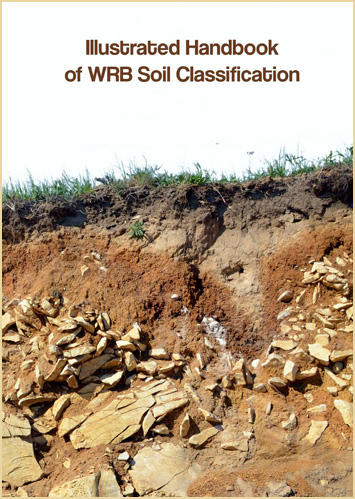Illustrated Handbook of WRB Soil Classification
International soil classification system for naming soils and creating legends for soil maps
Link zum Volltext (Open Access)
Zum Field Guide, der in der WRB 2022 enthalten ist, ist von Marcin Świtoniak et al. das Illustrated Handbook of WRB Soil Classification mit Fotos zu den zu beschreibenden Merkmalen veröffentlicht worden.
Soil classification is a difficult issue and requires many years of study under the guidance of experienced teachers. In the course of long-term studies and field research, soil scientists acquire the skills of recognizing and correctly naming many important features resulting from litho-, anthropo- or pedogenic processes. The problem with learning the secrets of this art is the lack of opportunity to see many examples of different soil features hidden beneath the earth's surface. Visiting many regions of the world for didactic or scientific purposes, we felt the need to share our photographic collections with other people involved in the study and interpretation of the soil environment. It is with great pleasure that we present to the reader a set of several hundred photographs showing the features, properties, soil horizons, as well as examples of interpretation of soil profiles – in accordance with the rules and nomenclature adopted in the international soil naming and classification system – the World Reference Base for Soil Resources (2022). The book has been divided into eight chapters with a total of 300 pages. The photos have been arranged in such a way as to reflect the process of creating a description of the soil profile - from environmental features, through morphological soil features, diagnostic horizons, properties, and materials, to specific examples of soil profile classification. In the section with soil profiles, we managed to collect 100 examples from all Reference Soil Groups found in all climatic zones of our planet. In the names of the soils, we have mainly emphasized those features (qualifiers) that are morphologically identifiable in the photos, consciously omitting those that can only be read from the results of laboratory analyses. The prepared textbook is a continuation and development of a simplified student WRB guide published by Świtoniak et al. (2018). In this previous book, nomenclature and examples of soil description and qualifiers were limited to the environments of Central and Eastern Europe. The "Illustrated Handbook of WRB Soil Classification" contains a collection of photos from different parts of the world, and their selection was intended to show as much as possible the diversity of the world's soil cover. The book opens with Chapter 1 which contains examples of environmental and soil surface features with their short descriptions in the context of use in describing the surroundings of a soil pit. In Chapters 2 through 6, the reader is guided through extensively inventoried examples of detailed soil features and horizons, properties, and diagnostic materials. It should be noted that full definitions of the soil features required in the WRB were not used, but only simplified descriptions aimed at drawing attention to the characteristic morphological features, that facilitate their recognition in the field. The core of the study is Chapter 7 - a list of 100 soil profiles, presented in order according to the Reference Soil Groups key in the WRB (2022). Each soil photo was accompanied by a thumbnail showing the depth of occurrence of individual features determining the classification position of the soil, both the RSG and the use of main qualifiers. The description of particular parts of the soil names (RSG and qualifiers) has been simplified in order to link the interpretation of a given names with recognizable morphological features of the soil. The book ends Chapter 8 with photos showing the general principles of using specifiers and additional examples of selected qualifiers with their general descriptions. Therefore, the handbook is not able to replace the formal key for soil determination in accordance with WRB, it is only a complementary, additional tool containing a database of photographic examples for wide use by people involved in soil classification.
